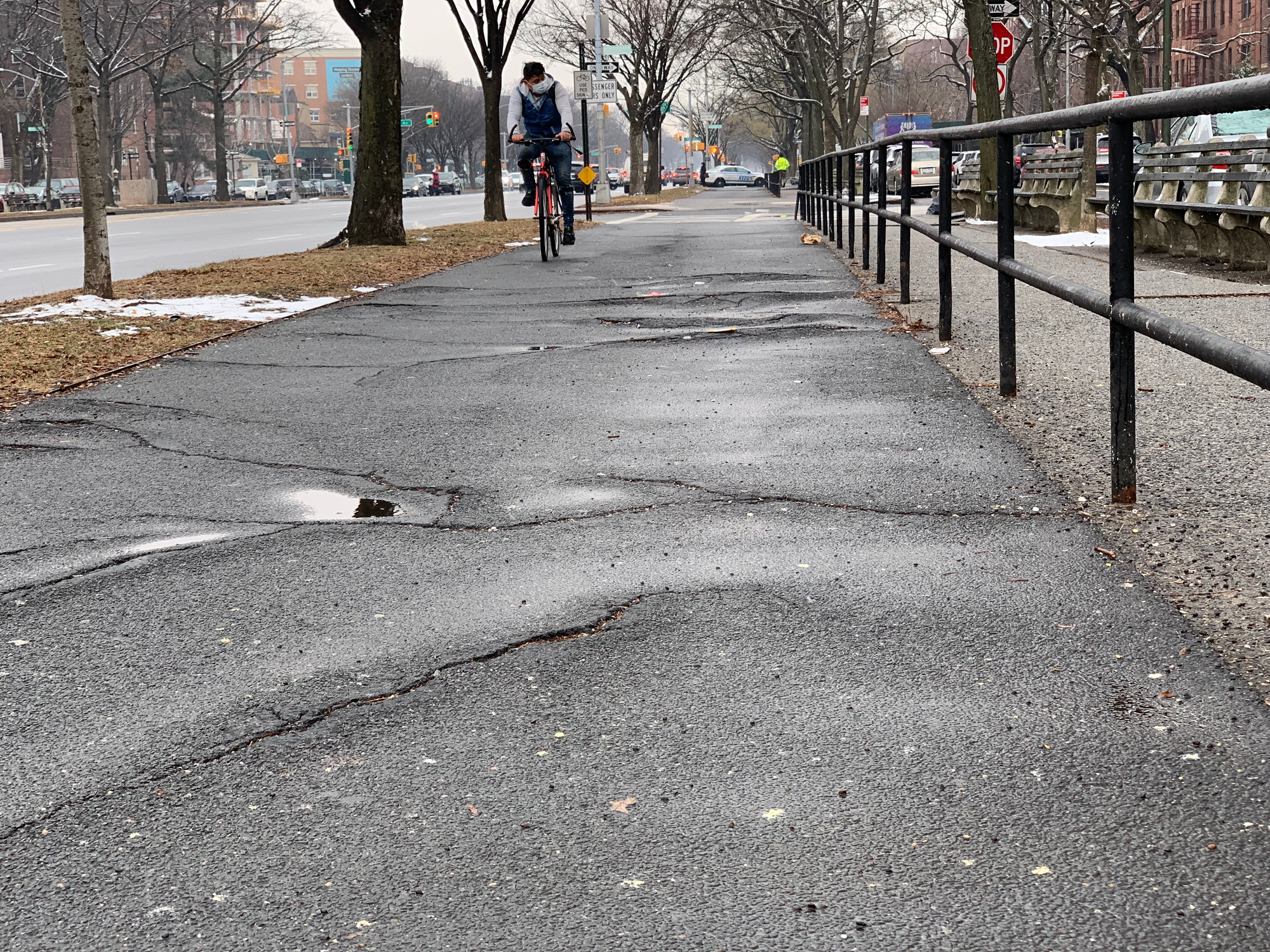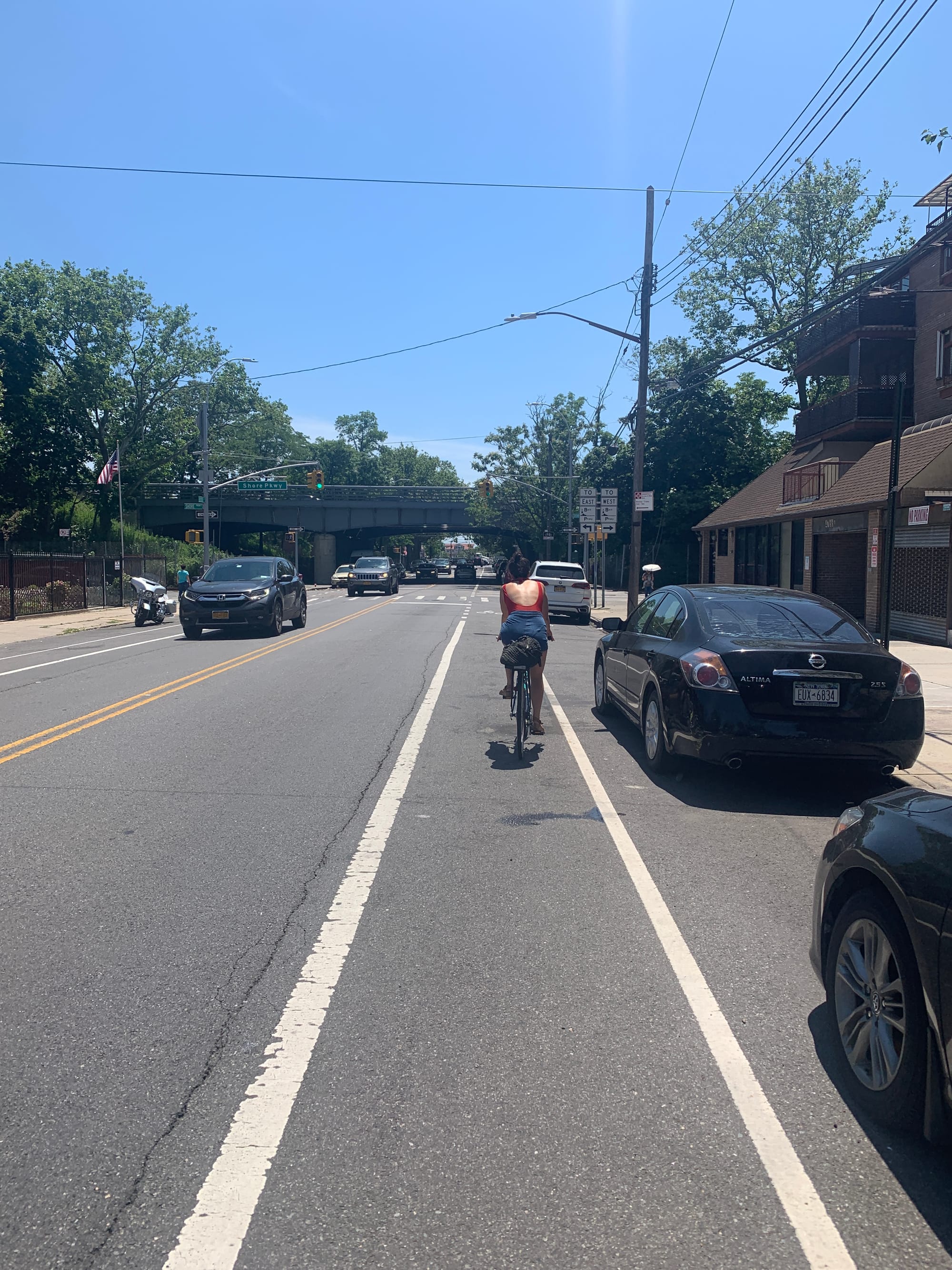A better bike route than the historic, 'embarrassing' path
The nation's first bike lane opened in 1894 in Brooklyn, but you're best not riding it

To assess the state of America’s first bike lane — the five-mile Ocean Parkway greenway that opened in Brooklyn in 1894 — all you need is to look at one sign near its south end, just below Neptune Avenue. A yellow diamond warns cyclists on the path: WALK YOUR BIKE. The sign is planted at an intersection where the crisscross of streets creates dangerous crossing conditions.
“That’s America’s first bike path. The fact that we have ‘walk your bike’ signs is just an embarrassment,” Jon Orcutt, the director of advocacy at Bike New York, told The Groove of the path that connects Prospect Park and Coney Island. “It’s more of a relic than an actively celebrated and managed facility. I moved to the city in the ’80s; Ocean Parkway looks pretty much exactly the same.”
The Ocean Parkway greenway — America’s first designated bike lane — was the brainchild of master parks builders Frederick Law Olmsted and Calvert Vaux as an extension of Prospect Park, inspired by the grand European streetscapes like the Avenue de L’Imperatrice in Paris and the Unter den Linden in Berlin, Germany. It might seem like 1894 was the last time anyone actually worked on the pathway though.
“Worst bike path in the city easily, such a joke,” one Redditor commented on a post about its dangerous intersections.
The greenway should be an ideal, leisurely and breezy way for cyclists of any skill level to yeet themselves from Prospect Park to the beach on a beautiful summer day. But in reality, the path is in such disrepair that it immediately becomes an advanced level biking gauntlet, one that I’ve seen scare off new bikers. Overgrown tree roots have turned the smooth path into a bumpy, crotch-slamming mogul track; potholes and other cracks in the pavement pose tire-snagging hazards; in some parts, bikers have carved their own bypasses in the grass next to the path. Cross streets intersect with the greenway at odd angles, meaning cars stop in the intersections, making it impossible for pedestrians and cyclists to continue their journey.

The city is home to a lot of historic firsts that get their due: you can still ride the first modern wooden escalator at the Herald Square Macy’s or get a pizza at Lombardi’s in Nolita, the alleged “first” pizza shop. But America’s first bike lane has received no such special acclaim or attention over the years, falling into as much disrepair as any other chunk of overused asphalt in the city.
The good news: long-awaited repairs finally began on the bike path last year. It's created "a few seconds of serenity" on the completed portions, according to one rider. The bad news: the work only covers a seven-block stretch between Avenue R and Avenue X and it's painfully behind schedule — the original March completion date has been pushed back to November, just in time to miss beach season (the Parks Department did not respond to a request for comment).
Recently redone sections of ocean parkway #bikenyc path are feeling super smooth. Many other stretches still have issues (btwn ave M & N for sure) but thx @NYCParks @NYC_DOT for these few seconds of serenity. Cc @bikenewyork pic.twitter.com/wp4wFyeIZg
— paco (dave) abraham (@subtle116) April 19, 2024
Getting political support for more improvements isn’t easy in southern Brooklyn, Orcutt said, where more conservative politicians tend to treat bike lanes as another symptom of the woke mind virus.
“As they've taken a decade to get the six blocks under contract and work, the rest of the parkway continues to deteriorate,” Orcutt said.
Bike advocates have called for an overhaul to this whole process. Greenways are considered parks, and are managed by the Parks Department, and that department has a much slower process for doing construction than the Department of Transportation, which has its own equipment and paving crews. The Ocean Parkway path was never given its due respect as other streets were built around it too: few bike paths connect to it, so it’s not an integrated part of the bike system, Orcutt said.
“Even if the surface was good it would be annoying,” he said.
If you're waiting for New York City bureaucracy to unknot itself in a way that solves the simple concept of “biking to Coney Island safely,” you might have better luck waiting for all the tree roots that have torn up the path to suddenly un-grow themselves.
In the interim, I offer you a humble workaround:
How to have a much nicer bike ride to Coney Island (and other beaches)
It would be nice if we had a protected greenway that took you all the way to the beach so you weren’t always reliant on the transit system that Gov. Kathy Hochul choked out earlier this summer; it would be nice if sarcastic blog posts were gold ingots too, but that’s not the world we live in. Instead of subjecting yourself — or worse, your bike-skeptical friends — to the endurance track of the Ocean Parkway bike path, try this instead:
Bike down Bedford Avenue basically the whole way. There are other parallel streets to use, but Bedford is an ideal way to ride, a straight shot from Eastern Parkway that takes you directly to the shore of Sheepshead Bay, with a brief ride to reach the boardwalk. Bedford has an on-street bike path next to parked cars, though the traffic on the road is usually relatively light, and traffic does not block the intersections the way it does on Ocean Parkway.

But the route itself is a marvel of the diversity of neighborhoods Brooklyn has to offer. You will ride by the historic buildings of Flatbush, pass through the green campus of Brooklyn College, get a peek at Bernie Sanders' old high school, ride by Midwood homes with tidy lawns, soar through the brick rowhouses of Sheepshead Bay, all under a bike path shaded by old-growth trees and dappled by sunlight passing through the leaves. The path spits you out in Sheepshead Bay, a short waterfront ride to the Neptune Avenue bike lane that will get you to Coney Island (with a short side quest to Roll-N-Roaster if you like).
Even better: it’s not actually longer than taking the Ocean Parkway route. Both routes are basically 7.6 miles long from Eastern Parkway, and take about 45 minutes of biking.
If you’re looking for a more serene beach, take a left when you reach the water of Sheepshead Bay instead of a right: the path continues along the water, picking up again in a lovely off-road track that will take past Plumb Beach and all the way to the Gil Hodges Bridge, your access point to Jacob Riis and Fort Tilden beaches. There is a part of this path where you sweat it uphill, and just as you crest the incline, you can look out over the bay and see the beach and the ocean in the distance, enticing you on. This is the greatest bike route in the world, to me.
For the record, Orcutt disagrees with me about the Bedford route. He doesn’t like that it’s an on-street four-foot-wide lane next to parking. He uses the southbound Nostrand Avenue bus lane instead — “it’s big and wide” — but notes you have to be pretty fast to stay ahead of the actual buses.
For those braving the Ocean Parkway gauntlet, he offers this advice:
“It's a separate bike path but you have to be super vigilant because of the way it interacts with the street. Keep a look over your shoulder, someone could take a high speed right and wack you. You have to watch pedestrians, signals and street surfaces, because it’s not good in a lot of cases.”

Comments ()